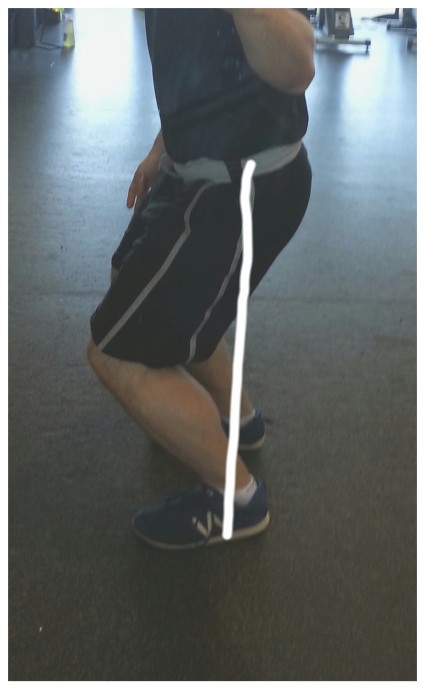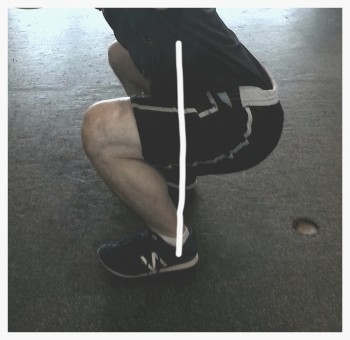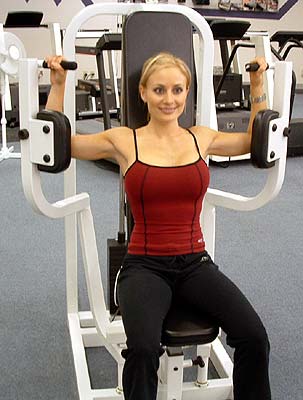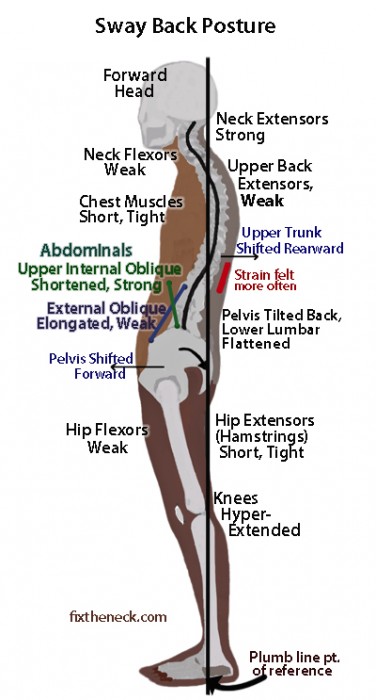Free Motion Squat Machine:
Want to learn how NOT to squat correctly?……Do this.
Why it’s jacked-up: You’re feet are out in front of you and your hips and back are locked into the pad. It teaches you to hinge from the knees and NOT the hips. Hell you physically CAN NOT hinge the hips.
This means ALL QUADS, very little glute (only if you get low enough), and NO hamstrings.
Ask someone to squat and 99 out of 100 times they break at the knees and move forward.
In a good squat you should break from the HIPS and sit BACK into the motion. Think about it this way:
If you had to take a crap in the woods you wouldn’t sh@t on your feet, you’d sh@t behind them.


Bad Squat Pattern= Messy Shoes Good Squat Pattern= Clean Shoes.
Obviously the white line is a reference point for the line of action, NOT the line of fecal matter.
The right would be the proper squat pattern, the same one we try to program with the Wall Squat.
To squat correctly you MUST sit back into the hips and use the glutes and hamstrings, any machine that’s not allowing you to do this is reinforcing a bad motor pattern and leaving you jacked-up in the end.
Leg Extension Machine:
Why it’s jacked up: Again, movement initiated by the knee is usually a bad thing. Ummmm, this is ONLY movement from the knee and NOTHING else and worse than that it’s in an “Open Chain” situation.
Open Chain: The terminal joint is not stable/ grounded. In this case the foot/ ankle is the terminal joint and is in an “open” ungrounded position.
These factors together mean that the quad is the ONLY muscle that can create motion, which is great for bodybuilders who are looking to isolate the muscle, but terrible for MOST people because it causes rotation at the knee, especially during the lowering portion of the exercise.
Knees are primarily meant to HINGE not ROTATE (although, yes there is some rotational abilities which is what we’re trying to control here anyway).
Great explanation of knee movement here:
Point is: We don’t want uncontrolled rotation of the knee-joint, it’s a good way to grind down the surfaces and put undo pressure on the ligaments, tendons and cartilage.
Pec Deck:
Photo Creds: angrytrainerfitness.com
Why it’s Jacked-Up: This machine allows for and encourages a range of motion that over stretches the anterior (front) of the shoulder joint. Laxity to the anterior of the shoulder joint is how DISLOCATIONS happen.
To compound the problem, this overstretching is under a lot of muscle tension which will cause the posterior of the shoulder joint to shorten and tighten in an effort to keep the head of the Humerus (upper arm bone) centered in the joint.
This usually means an upward rotation of the scapula and internal rotation of the Humerus.
Once you get this compensation at the scapula, and reach back in the Pec Deck, the top of the Humerus doesn’t have any room, it rubs against the scapula and leads to shoulder impingement…..and pain.
*Caveat: This machine can be used successfully by setting up correctly, NOT USING THE “HANDS UP” version, and CONTROLLING the range of motion. Basically this means use the hands out in front version (not the one shown here), set up with the shoulders down and hands below the plane of the shoulder, and hands go no further back than in line with the front of the ribs.
Ab Machine:
Why it’s Jacked-Up: It functions EXACTLY the same way as the machine used in research to dislocate spinal discs.
Think about that….
You really shouldn’t need more of an explanation. But there is more…here, here, and…
Elliptical:
Why it’s Jacked-Up: The Elliptical doesn’t force you into a bad pattern, but do it long enough and you’ll develop one.
At first most Elliptical users lift their heels.
This happens because when you walk normally you lift your heels because as you toe off while taking a step you are using the stored energy in the Achilles tendon to help propel yourself forward.
The elliptical however has no impact, therefore the Achilles never has to “load up” to help propel you forward.
What happens after a while on the Elliptical is the body figures this out and takes the Achilles out of the equation and shifts the focus to the muscles entirely, which sounds good, but remember these things (muscles, ligaments, tendons) were formed to work together and act in unison to absorb and distribute forces.
The result is a heel that stays down (flat) during the motion.
This is bad because a heel that stays flat while the ankle flexes stretches out the Achilles tendon. Do this enough and you develop the “default pattern” of a flexed ankle and a permanently stretched out Achilles tendon.
A permanently stretched out Achilles tendon is VERY, VERY BAD.
As a result every joint from the ankle up has to change its angle and move from neutral as a result of the joint before it being out of alignment and a “Sway Back” posture.
Photo from fixtheneck.com
See?
Once the ankles are forced to flex, so the Achilles tendon can be at tension everything else along the chain MUST change. Remember, the Achilles tendon is the strongest/ thickest tendon in the body for a reason, the body will ALWAYS do what it takes to get the Achilles at normal tension, even if this means defaulting to a flexed ankle to achieve it.
Keep in mind, I’m not saying that using the Elliptical or ANY of these every now and then will leave you in a body bag.
That won’t happen.
But if you use them enough you’re reinforcing and developing bad motor patterns. Which eventually will always lead to some issue eventually.





I am actually delighted to read this blog posts which contains plenty of valuable
facts, thanks for providing these kinds of data.
if like me you’ve been using an elliptical for years and have just noticed the symptoms listed here, what recommendations are there for correcting this?
Tad,
Get off the elliptical. You just need to restore the elasticity of the Achilles. Things as simple as walking, jumprope without going to fatigue, and strengthening the hips and ankles can help.
It really depends on a number of factors but you want to load and us the Achilles as you would in everyday life and your hips (glutes) can never be strong enough, that almost always helps with lower body issues of any sort.
Thanks very much Roy, I’ll get off and replace with cycling from now on.